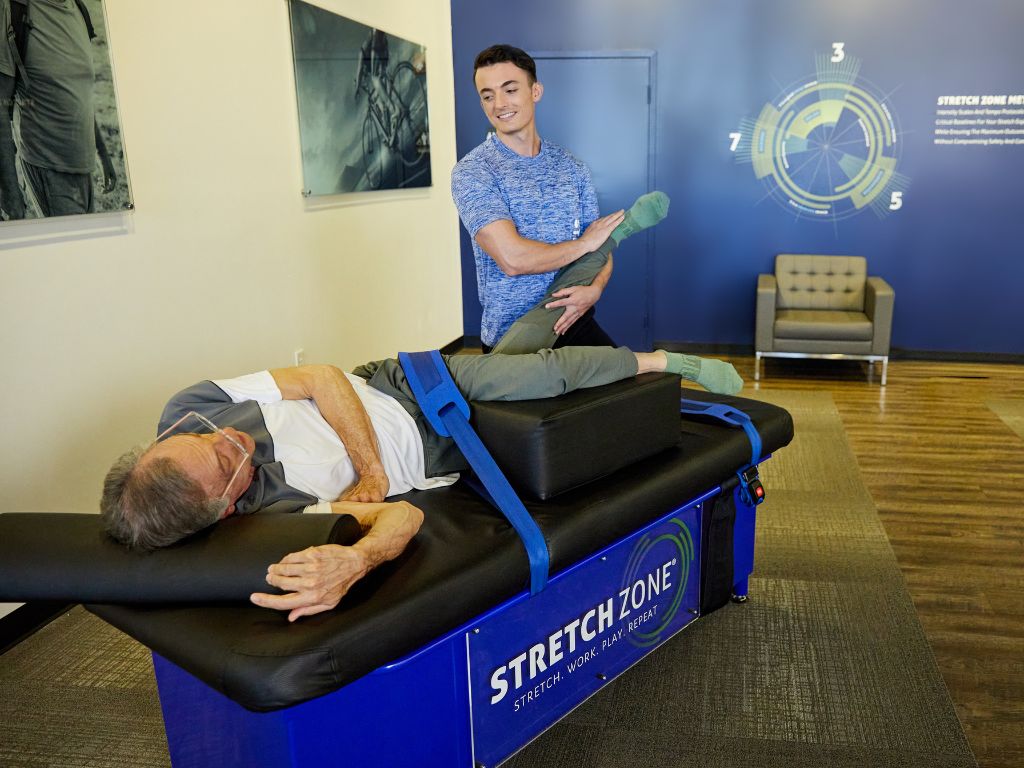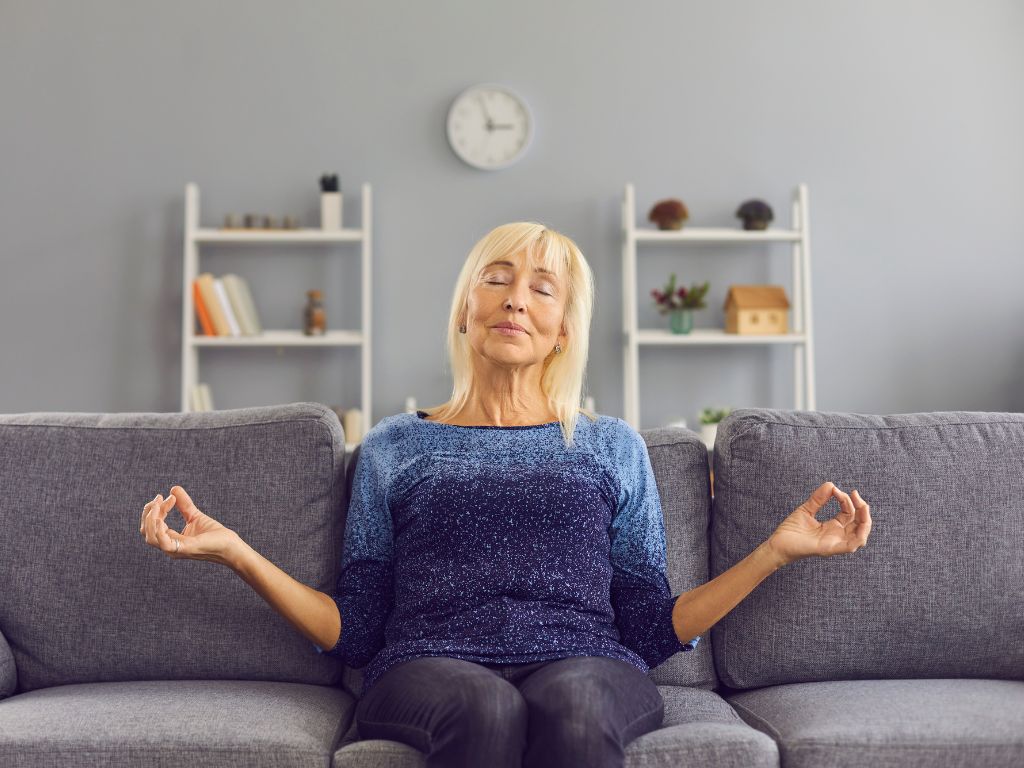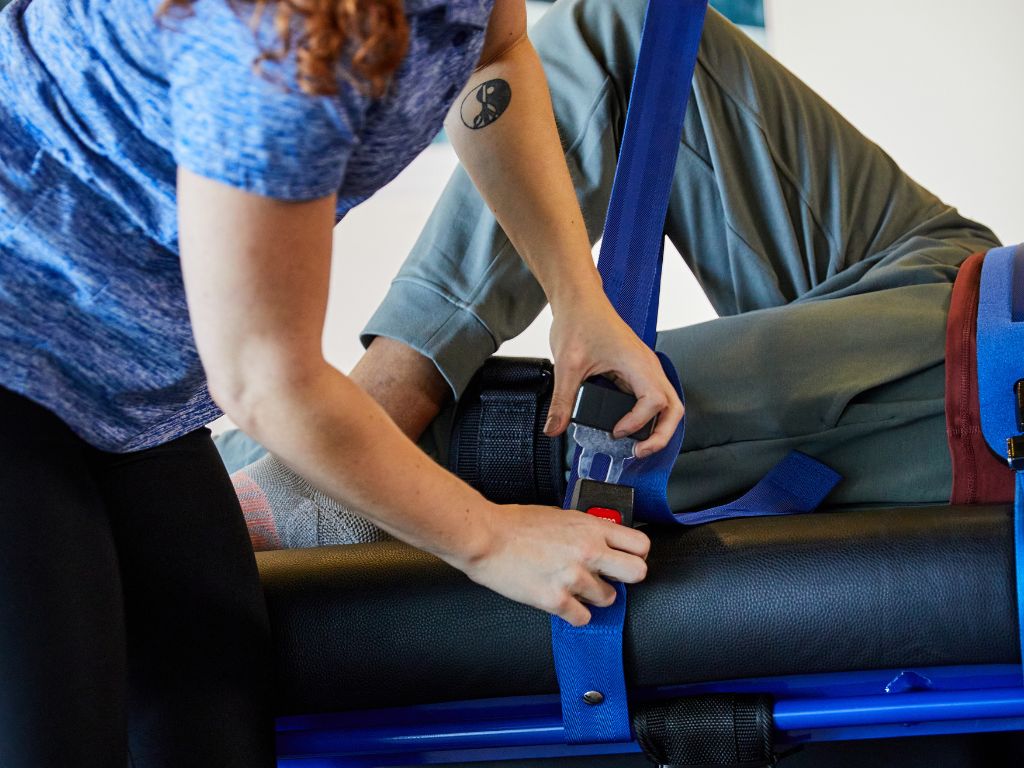
The Mind-Body Connection: How Stretching Soothes Stress
In the hustle and bustle of our daily lives, stress becomes an all-too-familiar companion. Its presence often goes unnoticed, slowly building up like a hidden pressure cooker within us, leaving both our bodies and minds feeling tight and tense. In the midst of life’s demands, it’s essential to find moments of respite and relief. This is where the simple yet powerful practice of stretching steps in, offering a gentle and effective strategy to prevent and alleviate stress.
Whether as a way to stay ahead of stress or find comfort in tough times, stretching for stress relief invites us to slow down, take a deep breath, and find peace within. Let’s explore how this practice can release tension, soothe stress, and nurture our bodies and minds.
Understanding Stress and its Effects on the Body
Being stressed is a common experience that affects us all at some point in our lives. It’s that feeling of pressure, tension, or being overwhelmed that arises when we face challenging situations, big changes, or demanding responsibilities. While stress is a natural response, it’s essential to understand its impact on both our mental and physical well-being.
Stress can be described as our body’s reaction to external or internal demands that require us to adjust or cope. It’s important to note that not all stress is harmful; in fact, some stress can be motivating and help us rise to the occasion. However, prolonged or excessive stress can take a toll on our health and quality of life.
How Stress Affects Mental Health
Stress has a significant impact on our mental health, influencing our thoughts, emotions, and behavior. When we experience high levels of stress, it can lead to feelings of anxiety, irritability, and even depression. It may be challenging to concentrate or make decisions, and we might find ourselves becoming more forgetful or easily overwhelmed.
Long-term stress can also affect our sleep patterns, leading to insomnia or disrupted sleep, which further exacerbates mental and emotional distress. It’s not uncommon to feel a sense of helplessness or a loss of control when stress becomes overwhelming, potentially leading to a vicious cycle of negative emotions and thoughts.
How Stress Affects Physical Health
Beyond its impact on mental well-being, stress can also manifest physically. The body’s response to stress triggers the release of stress hormones, such as cortisol and adrenaline, which prepare us for the “fight-or-flight” response. While this response can be life-saving in emergencies, chronic activation of these stress hormones can harm our health.
Physical symptoms of stress may include headaches, muscle tension, digestive issues, and increased heart rate. Long-term stress has been linked to weakened immune systems, making us more susceptible to illnesses and infections. It can also contribute to the development or worsening of certain health conditions, such as high blood pressure, heart disease, and chronic discomfort.
Role of the Mind-Body Connection in Managing Stress
The mind-body connection plays a crucial role in how we perceive and cope with stress. Our thoughts, emotions, and physical sensations are closely interconnected, influencing each other in complex ways. Recognizing this connection is vital in managing stress effectively.
Practices that promote the mind-body connection, such as mindfulness, meditation, and stretching for stress relief, can be powerful tools. Mindfulness allows us to be present in the moment without judgment, helping us observe and acknowledge our stressors with greater clarity. Meditation enables us to quiet the mind and cultivate a sense of calm and inner peace, reducing the physiological response to stress.
Stretching plays a crucial role in managing stress. When we stretch our muscles, we release tension, promote blood flow, and trigger the body’s relaxation response. This physical release can have a direct impact on our mental well-being, helping us feel more at ease and less stressed.
The Science of Stretching for Stress Relief
Stretching is not just about touching our toes or reaching for the sky. It holds a remarkable power to soothe stress and promote overall well-being. Let’s delve into the science behind stretching and how it can be an ally in the battle against stress.
Benefits of Stretching for the Body
Enhances Blood Circulation
When we stretch, our muscles contract and relax, creating a pumping action that encourages blood flow throughout the body. Improved blood circulation means that oxygen and essential nutrients reach our organs and tissues more efficiently, aiding in their proper functioning. This enhanced blood flow also helps to flush out waste products and toxins, leaving us feeling more refreshed and rejuvenated.
Releases Muscle Tension
One of the most tangible benefits of stretching for stress relief is its ability to help alleviate muscle rigidity. When we experience stress, our bodies tend to tighten up, leading to knots and discomfort in our muscles. Stretching helps to lengthen and relax these muscles, alleviating the physical manifestations of stress. As our muscles unwind, we can experience a sense of relief and lightness, easing the burden stress places on our bodies.
Benefits of Stretching for the Mind
Mindfulness and Meditation Aspects
Stretching can serve as a gateway to mindfulness and meditation. By focusing on the sensations and movements of our bodies during stretching, we become more attuned to the present moment. This mindful awareness helps us let go of anxious thoughts about the past or future, allowing us to find peace and clarity in the here and now. Stretching becomes a form of moving meditation, grounding us in the present and reducing stress’s mental toll.
Stress Hormone Regulation
When stress takes hold, our bodies release stress hormones like cortisol and adrenaline, preparing us for challenges. While these hormones are helpful in the short term, chronic stress can lead to an excess of these chemicals, wreaking havoc on our well-being.
Stretching triggers the body’s relaxation response, prompting the release of feel-good hormones like endorphins and reducing the production of stress hormones. This hormonal balance fosters a calmer and more relaxed state of mind.
Connection with the Parasympathetic Nervous System
The autonomic nervous system plays a crucial role in managing stress. Within this system, the parasympathetic nervous system acts as the body’s “rest and digest” mode, counterbalancing the “fight or flight” response of the sympathetic nervous system.
Stretching for stress relief activates the parasympathetic nervous system, promoting relaxation and reducing stress levels. This shift in our nervous system’s activity can lead to a deeper sense of tranquility and emotional well-being.
Incorporating stretching into our daily routines can be a potent antidote to stress. As we stretch and connect with our bodies and minds, we unlock a powerful ally in the pursuit of stress relief and holistic harmony. Embrace the transformative potential of stretching and allow yourself to find serenity amidst life’s challenges.
The Brain’s Response to Stress and Stretching
When we encounter stress, our brain activates the amygdala, a region responsible for processing emotions like fear and anxiety. This triggers the release of stress hormones, preparing our body for action. In response, our heart rate and blood pressure rise, and we enter a state of heightened alertness.
However, stretching for stress relief can intervene in this response. As we stretch, we engage the body in gentle movements that signal to the brain that we are safe and not under immediate threat. This initiates the relaxation response through the parasympathetic nervous system, countering the stress-induced activation of the sympathetic nervous system. As a result, our heart rate and blood pressure begin to decrease, and our body enters a state of calmness and balance.
Neurotransmitters and Hormones Involved in the Stress-Reducing Effects of Stretching
Stretching influences the release of essential neurotransmitters and hormones that contribute to stress reduction:
- Endorphins: Stretching prompts the release of endorphins, which are our body’s natural painkillers and mood enhancers. These neurotransmitters create feelings of pleasure and well-being, helping to alleviate stress and lift our spirits.
- Serotonin: Stretching can also increase serotonin levels in the brain. Serotonin is often referred to as the “happy hormone” because it regulates mood and promotes feelings of contentment. Adequate levels of serotonin are essential for managing stress and reducing anxiety.
- Cortisol Regulation: Chronic stress can lead to elevated cortisol levels, which can be harmful to our physical and mental health. Regular sessions of practitioner-assisted stretching help bring cortisol levels back into balance, preventing the detrimental effects of prolonged stress.
The combination of these neurotransmitters and hormones creates a neurochemical environment in the brain that supports stress relief and emotional well-being. As we stretch, we pave the way for a more relaxed, positive, and balanced state of mind.
The Effectiveness of Practitioner-Assisted Stretching for Stress Relief
While solo stretching can be beneficial for stress relief, the practice of practitioner-assisted stretching offers unique advantages that can make it even more effective in reducing stress and promoting relaxation.
Customized and Targeted Approach
Practitioner-assisted stretching for stress relief involves working with a trained professional who can customize the stretching routine to address individual needs and specific areas of tension. Unlike solo stretching, where we may follow general routines or exercises, a stretch practitioner can assess our unique stress-related concerns and tailor the stretching session accordingly.
By targeting specific muscle groups and areas of tightness, a skilled stretch practitioner can apply gentle and precise techniques to release deep tension. This personalized approach allows for a more comprehensive and effective stress-relief experience, maximizing the benefits of stretching for both the body and the mind.
Enhanced Mind-Body Connection
During practitioner-assisted stretching, the practitioner guides clients through the movements while providing cues for proper alignment and breathwork. This hands-on guidance enhances the mind-body connection, allowing us to fully focus on the sensations and release experienced during stretching.
The presence of a practitioner can create a calming and reassuring environment, fostering trust and relaxation. As a result, we can feel more comfortable letting go of stress and emotional tension during the session. This heightened mind-body connection deepens the relaxation response, enabling us to access a state of greater serenity and calmness.
Passive Relaxation and Reduced Effort
Practitioner-assisted stretching involves passive stretching, where the stretch practitioner takes an active role in gently moving our body into stretches. In contrast to solo stretching, where we actively engage our muscles to perform the movements, passive stretching requires minimal effort.
This reduced physical effort allows for a more profound state of relaxation, as our bodies can fully surrender to the practitioner’s guidance. With the responsibility of movement delegated to the practitioner, we can let go of any lingering tension or stress, allowing our bodies and minds to experience a deeper sense of ease and release.
How Does Practitioner-assisted Stretching Help With Stress Consequences?
Enhancing Sleep Quality
Practitioner-assisted stretching emerges as a valuable tool to improve sleep quality and foster relaxation. Under the skilled guidance of a stretch practitioner, passive stretching allows individuals to fully surrender physical tension, paving the way for a more profound state of tranquility.
By working with a practitioner to release accumulated stress and muscle tightness, clients can experience more restful sleep, awakening refreshed and rejuvenated.
Stretching and Emotional Release
The undeniable link between emotions and physical tension finds a remarkable outlet in practitioner-assisted stretching for stress relief. Unexpressed emotions, stress, and anxiety can manifest as tightness and discomfort in various parts of our bodies. Practitioner-assisted stretching becomes a powerful tool for facilitating emotional release and catharsis, promoting emotional well-being alongside physical flexibility.
Enhancing Flexibility and Physical Resilience
Practitioner-assisted stretching serves as a gateway to enhanced flexibility and physical resilience. By engaging in regular stretching sessions with a skilled practitioner, individuals can improve their range of motion, reduce muscle stiffness, and enhance their physical performance. The increased flexibility fosters a sense of freedom and agility, empowering us to navigate life’s challenges with greater ease and grace.
Stress Prevention
As a proactive approach to safeguarding our well-being, stress prevention finds a potent ally in practitioner-assisted stretching. Collaborating with a stretch-practitioner allows individuals to craft customized stretching routines that target stress-prone areas and promote relaxation.
This personalized approach deepens the mind-body connection, enhancing our ability to recognize and address stress triggers before they escalate. Embracing practitioner-assisted stretching as a preventive measure empowers us to release tension, maintain emotional balance, and build resilience against the impact of stress.
Having a “You” Moment
Practitioner-assisted stretching offers a unique opportunity to indulge in a blissful “you” moment. During these guided sessions, you can set aside the distractions of daily life and immerse yourself fully in the present. With the practitioner’s supportive presence and gentle guidance, individuals can embrace a meditative experience, cherishing the undivided attention focused on their well-being.
This precious “you” moment becomes a rejuvenating escape from the demands of the outside world, allowing for self-discovery, relaxation, and a deeper connection with oneself.
Combining Stretching with Other Mind-Body Practices
Embrace Mindfulness
Enhance your practitioner-stretching experience by weaving mindfulness into the fabric of your routine. As you engage in stretching exercises, center your attention on the present moment, becoming fully aware of the sensations and movements within your body.
Allow your breath to guide you, anchoring you to the here and now. By integrating mindfulness into your stretching for stress relief practice, you can cultivate a deeper mind-body connection, promoting a profound sense of inner peace and clarity.
Embrace the Stillness of Meditation
After each stretch, take a moment to pause and observe the sensations in your body and mind. Allow any thoughts or emotions that arise to pass without judgment, embracing a sense of spacious awareness. Integrating meditation into your stretching sessions fosters a sense of grounding and inner serenity, promoting emotional balance and mental clarity.
Cultivate Breathwork
Elevate your stretching experience by incorporating intentional breathwork. As you move through each stretch, synchronize your breath with your movements. Inhale deeply as you prepare to stretch, and exhale slowly as you deepen the stretch. Focused breathwork enhances oxygen flow to your muscles, promoting relaxation and reducing tension.
Holistic Stress Management
Embrace the power of multi-dimensional approaches to stress management by weaving stretching into your weekly self-care routine. Combining various mind-body practices can create a holistic tapestry of well-being, supporting your physical, emotional, and mental resilience against the challenges of life. As you integrate stretching for stress relief with mindfulness, visualization, relaxation, meditation, and breathwork, you create a symphony of healing practices that nurture your entire being.
When Stress Feels Overwhelming
While stretching and mind-body practices can be powerful tools in managing stress, there are times when stress may feel overwhelming and beyond our ability to cope. During such moments, remember that seeking professional guidance can be a transformative step toward finding balance and relief. A licensed therapist, counselor, or wellness expert can provide personalized support tailored to your specific needs.
Whether it’s chronic stress, anxiety, or other stress-related concerns, professional guidance can offer valuable insights and support on your journey to emotional well-being.
Ready to Try Practitioner-Assisted Stretching for Stress Relief?
Discover the transformative power of practitioner-assisted stretching at Stretch Zone! Amidst life’s daily stresses, find a sanctuary of serenity and relaxation in our guided stretching sessions. Our skilled practitioners will not only enhance your sleep quality, promote emotional well-being, and alleviate tension but also help combat the consequences of stress.
With personalized routines and expert guidance, we empower you to build physical resilience and emotional balance. Embrace a journey of self-discovery and wellness and schedule your 30-min session today!


